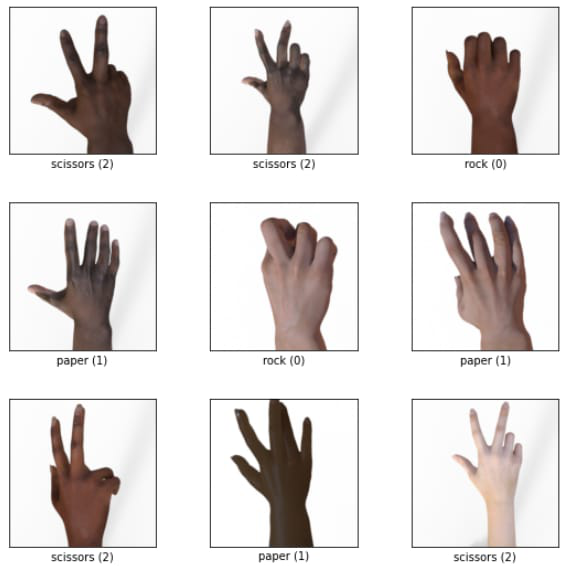TensorFlow中的卷积神经网络(CNN)的训练
在这篇文章中,我们将使用TensorFlow这个大规模的机器学习库来实现和训练一个卷积神经网络CNN。
在这篇文章中,我们将在一个名为 “石头剪刀布 “的数据集上工作,我们需要将手势简单地分类为石头和剪刀。
一步一步实现
第1步:导入库
我们将从导入一些重要的库开始。它们是TensorFlow、NumPy、Matplotlib,最后从TensorFlow中,我们需要TensorFlow数据集和Keras
pip install -q tensorflow tensorflow-datasets
# Importing the packages
import matplotlib.pyplot as plt
import numpy as np
import tensorflow as tf
import tensorflow_datasets as tfds
from tensorflow import keras
第2步:加载数据集
在选择数据集之前,请自由探索TensorFlow中所有可用的数据集。
tfds.list_builders()
输出:
['abstract_reasoning',
'accentdb',
'aeslc',
'aflw2k3d',
'ag_news_subset',
'ai2_arc',
'ai2_arc_with_ir',
'amazon_us_reviews',
'anli',
'arc',
'bair_robot_pushing_small',
'bccd',
'beans',
'big_patent',
....
..
.
在加载数据集之前,我们将看到关于我们的数据集的一些信息,这样我们就可以很容易地处理数据并收集一些非常重要的信息。
# Getting info about the dataset
Dataset = tfds.builder('rock_paper_scissors')
info = Dataset.info
print(info)
输出:
tfds.core.DatasetInfo(
name='rock_paper_scissors',
full_name='rock_paper_scissors/3.0.0',
description="""
Images of hands playing rock, paper, scissor game.
""",
homepage='http://laurencemoroney.com/rock-paper-scissors-dataset',
data_path='C:\\Users\\ksaty\\tensorflow_datasets\\rock_paper_scissors\\3.0.0',
download_size=Unknown size,
dataset_size=Unknown size,
features=FeaturesDict({
'image': Image(shape=(300, 300, 3), dtype=tf.uint8),
'label': ClassLabel(shape=(), dtype=tf.int64, num_classes=3),
}),
supervised_keys=('image', 'label'),
disable_shuffling=False,
splits={
},
citation="""@ONLINE {rps,
author = "Laurence Moroney",
title = "Rock, Paper, Scissors Dataset",
month = "feb",
year = "2019",
url = "http://laurencemoroney.com/rock-paper-scissors-dataset"
}""",
)
最后加载数据集。
# Loading the dataset
ds_train = tfds.load(name="rock_paper_scissors", split="train")
ds_test = tfds.load(name="rock_paper_scissors", split="test")
输出:
Downloading and preparing dataset Unknown size (download: Unknown size, generated: Unknown size, total: Unknown size) to C:\Users\ksaty\tensorflow_datasets\rock_paper_scissors\3.0.0…
Dl Completed…: 100%
2/2 [00:50<00:00, 25.01s/ url]
Dl Size…: 100%
219/219 [00:50<00:00, 4.38 MiB/s]
Dataset rock_paper_scissors downloaded and prepared to C:\Users\ksaty\tensorflow_datasets\rock_paper_scissors\3.0.0. Subsequent calls will reuse this data.
部分例子

第3步:分析和预处理图像
首先,为了保持干净,我们要对数据进行迭代,并将其存储为NumPy数组,取消图像的尺寸,并将其存储为train_images,以及带有标签的测试图像。
# Iterating over the images and storing
# it in train and test datas
train_images = np.array([image['image'].numpy()[:, :, 0]
for image in ds_train])
train_labels = np.array([image['label']
.numpy() for image in ds_train])
test_images = np.array([image['image'].numpy()[:, :, 0] for image in ds_test])
test_labels = np.array([image['label'].numpy() for image in ds_test])
然后,现在我们要重塑图像,然后将数据类型从uint8转换为float32,然后我们要将所有的值降到0到1,以使模型更容易从中学习。
# Reshaping the images
train_images = train_images.reshape(2520, 300, 300, 1)
test_images = test_images.reshape(372, 300, 300, 1)
# Changing the datatype
train_images = train_images.astype('float32')
test_images = test_images.astype('float32')
# getting the values down to 0 and 1
train_images /= 255
test_images /= 255
第4步:一个基本的卷积神经网络
现在我们要创建一个基本的CNN,只有2个卷积层,有一个relu激活函数和64和32内核,内核大小为3,并将图像平铺为一维数组,卷积层直接连接到输出层。
对于编译,我们使用Adam优化器,对于损失,我们使用SparseCategoricalCrossentropy(),对于度量,我们使用准确性和去适应数据。
# A convolutional neural network
# Defining the model
model = keras.Sequential([
keras.layers.Conv2D(64, 3, activation='relu',
input_shape=(300, 300, 1)),
keras.layers.Conv2D(32, 3, activation='relu'),
keras.layers.Flatten(),
keras.layers.Dense(3, activation='softmax')
])
# Compiling the model
model.compile(optimizer='adam',
loss=keras.losses.SparseCategoricalCrossentropy(),
metrics=['accuracy'])
# Fitting the model with data
model.fit(train_images, train_labels, epochs=5,
batch_size=32)
输出:

并对该模型进行评估
model.evaluate(test_images, test_labels)

正如你所看到的,在未见过的数据中,准确率非常低,这被称为模型过拟合,这意味着模型被训练数据过拟合,所以它不能处理未见过的数据,为了解决这个问题,我们可以稍微修改一下模型。
更好的卷积神经网络
我们可以通过增加以下内容来改进这个模型。
- Dropout nodes
- Pooling
- 完全连接的密集层
# A better convolutional neural network
# Model defining
model = keras.Sequential([
keras.layers.AveragePooling2D(6, 3,
input_shape=(300, 300, 1)),
keras.layers.Conv2D(64, 3, activation='relu'),
keras.layers.Conv2D(32, 3, activation='relu'),
keras.layers.MaxPool2D(2, 2),
keras.layers.Dropout(0.5),
keras.layers.Flatten(),
keras.layers.Dense(128, activation='relu'),
keras.layers.Dense(3, activation='softmax')
])
# Compiling a model
model.compile(optimizer='adam',
loss=keras.losses.SparseCategoricalCrossentropy(),
metrics=['accuracy'])
# Fitting the model
model.fit(train_images, train_labels, epochs=5,
batch_size=32)

现在,如果我们评估我们的模型,你可以看到模型已经改善了很多。

这些是训练卷积神经网络的步骤。
注意:你仍然可以对模型进行一些调整和转向,以提高准确性。IT是一个不断学习的过程。
 极客教程
极客教程